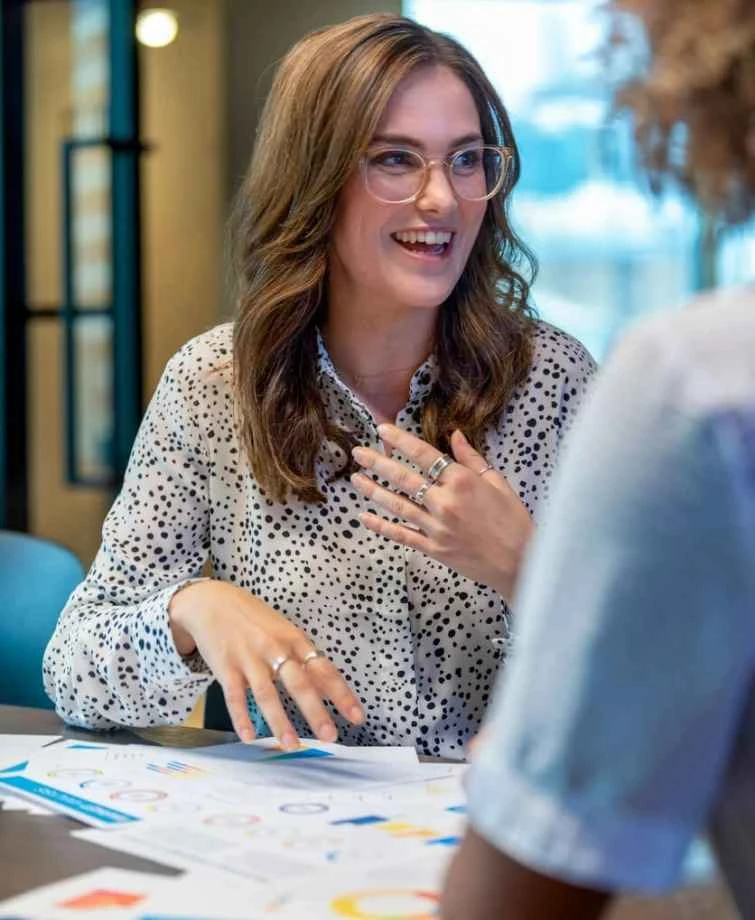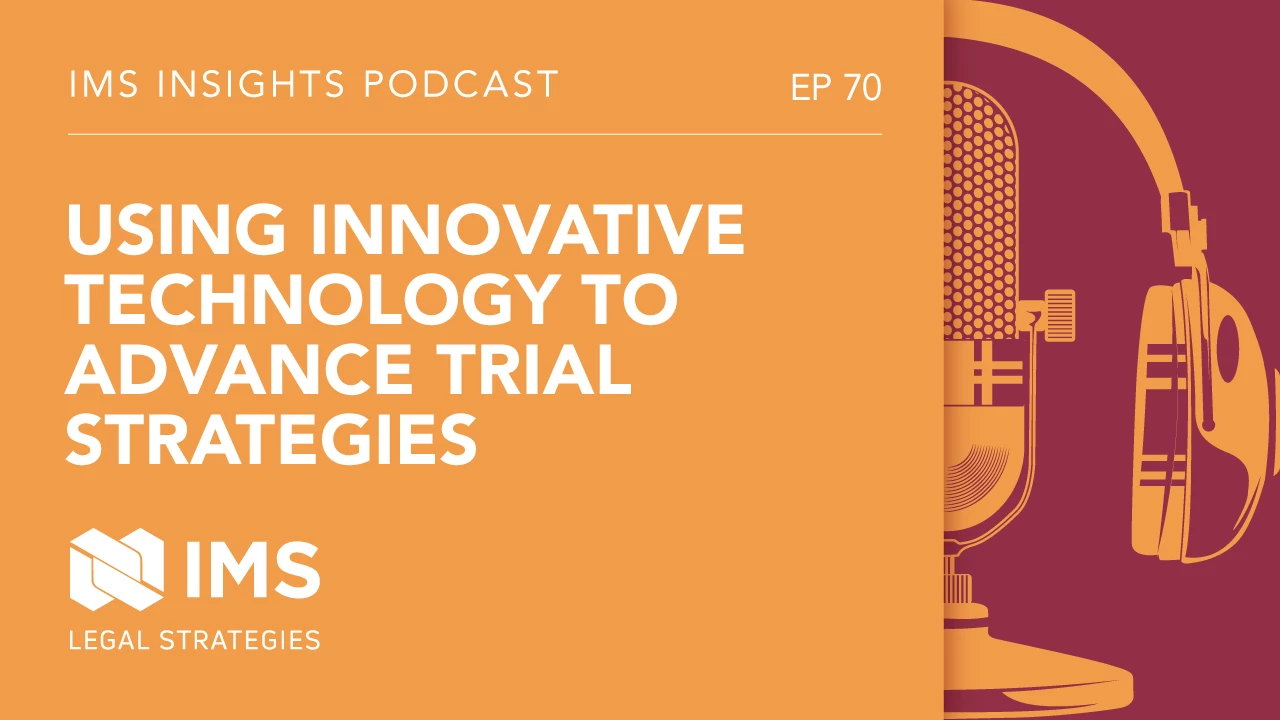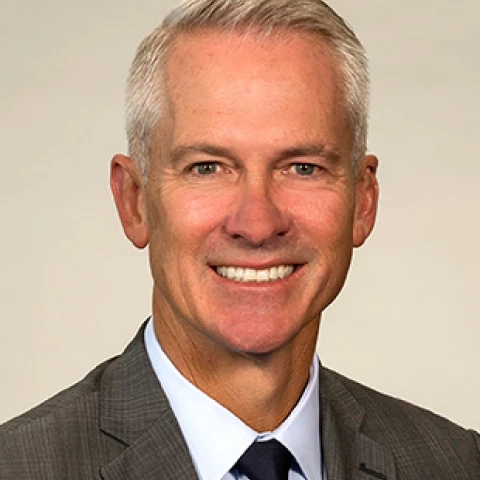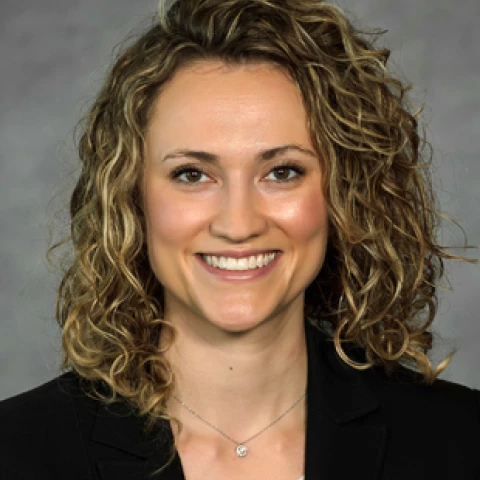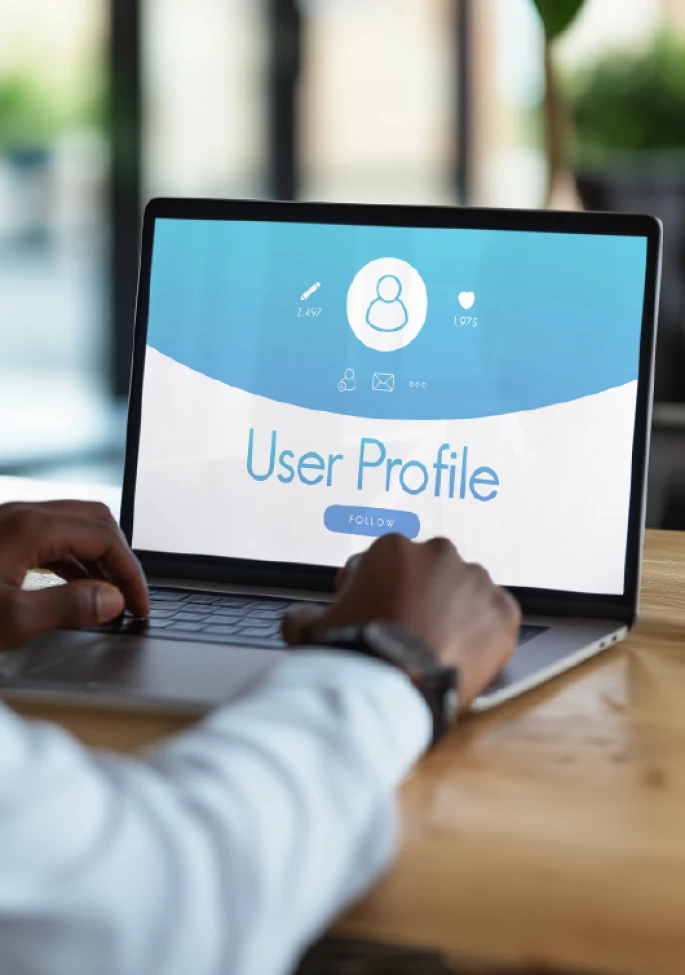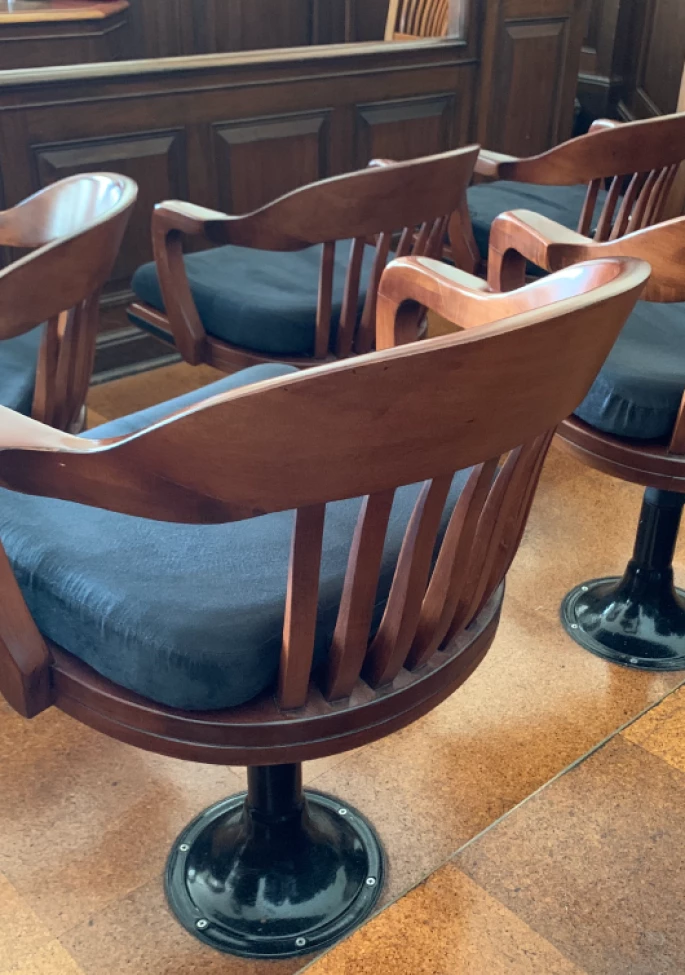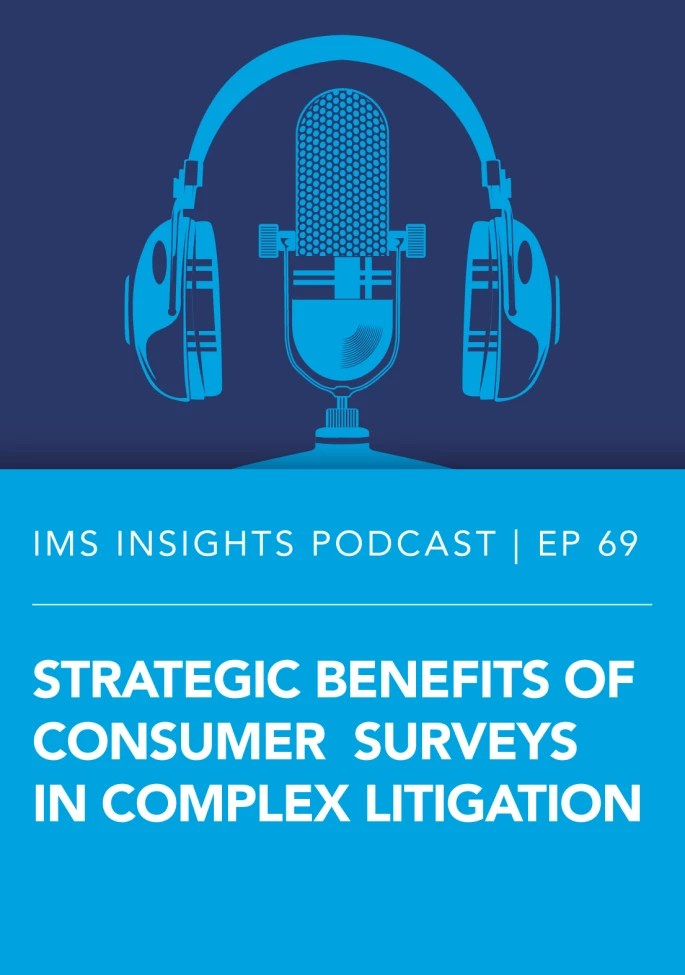This episode features IMS Senior Jury Consulting Advisor Chris Dominic alongside clients Trent Webb and Lauren Douville, both partners at Shook, Hardy & Bacon. Trent is also co-chair of the firm's intellectual property practice group. Our guests explore how to “supercharge the strategy process” through advancements in jury research technology.
Hello, and welcome to the IMS Insights Podcast. I'm your host, Adam Bloomberg. In this episode, we'll uncover how innovations in technology are giving trial teams a competitive advantage.
Joining me today is IMS Senior Jury Consulting Advisor Chris Dominic, along with Trent Webb and Lauren Douville, both partners at Shook, Hardy & Bacon. Trent is also co-chair of the firm's intellectual property practice group. So whether you're navigating IP litigation or other complex matters, you won't want to miss their expert insights. (If you enjoy our content, please like and subscribe to our channel.)
Adam Bloomberg: Welcome everyone. Trent, I'll start with you. How about the state of IP cases today and your overall client needs? How, or I should say, what do they want to learn about venues and the jury pool? And how does that play into your overall jury research strategy?
Trent Webb: That's a great question. First of all, I think it's no secret that jury verdicts are getting larger and larger. These cases are becoming much more risky to our clients, and so they are looking for any possible angle, any possible way to gain an advantage over your opponent—whether that be through the use of technology, AI, or, in this case, jury research—and how can we best learn about our potential jurors and potential outcomes using that advantage.
Adam Bloomberg: And Lauren, how about you?
Lauren Douville: I think one of the key things that we try to extract from any jury research exercise is really an understanding of, you know, how things may change from venue to venue. That is something that our clients are really interested in. So if we're in the Western District of Texas, for example, you know what's motivating a jury there as opposed to in the District of Delaware, or maybe the Northern District of California, where you often see these patent cases. And what we learn is that there are differences in how juries approach the issues in our cases in those different venues, and then how do we account for that? Particularly if we're on the plaintiff side or the defense side because there are obviously differences.
Adam Bloomberg: Chris, jury research is definitely a crucial step in a deeper understanding of a case, and you've been doing this for well over two decades, a really long time. Can you talk a little bit about how research projects have evolved over the years?
Chris Dominic: Well, sure the field's about 50 years old now, so there is a lot of development that's occurred, and it also means that our clients have become a lot more sophisticated, which has increased the quality of the feedback they give us, which direction we need to go to stay ahead. And the place that IMS is really ahead right now is in regard to process and technology. The process piece is about how we're now vertically integrated, which means we've got our own jury recruiting group who recruits focus group participants, mock trial participants, and makes them as representative as they can possibly be for these projects. And the technology side allows us to have people participating, whether the project is remote or live. And I mean, that is in if there's a live project, you will be able to participate with us remotely in the same way, you'll be able to see the same data, you'll be able to interact with that data, and you'll be able to interact with the team so that we have an even more collaborative project.
Adam Bloomberg: Speaking of remote technology, no one can deny the significance it's played in litigation in so many forms. How has technology helped you conduct jury research?
Chris Dominic: Yeah, well, this application we have developed is called The Advantage℠, and it is our data aggregation and analysis tool. And it basically allows anyone at any time, who has logged into the project to be able to see data in real-time connected to the project, and it allows everybody to independently cut the data in ways that they want. So, whether or not you're on the project, watching remotely, or watching live, you have the ability to see all the same data at the same time.
Adam Bloomberg: Trent, how about you, anything to add there?
Trent Webb: Yeah, that's a really interesting point that Chris just made. You know, mock trials are of very high interest to our clients. They always have been. But there have been some limitations on who could actually attend the mock trial exercise and drawing lines and deciding who can go, who can't. It can be problematic. Now, with this technology, everyone can attend and feel as though they're there in person and have access to all the same data and experiences. This includes all stakeholders, potentially non-lawyers, executives, and others who may have an interest in the case and want to learn more about how the case will be tried.
Adam Bloomberg: Lauren, can you describe the value you see in this technology?
Lauren Douville: So I think the real value lies in just having the aggregated data at our fingertips. We're able to make more decisions earlier in the day, particularly while the client is still in the room, or perhaps watching remotely and before any deliberations are taking place with the jurors. We can use this in a few different ways, including by adjusting presentations before they've happened or just getting more out of the day by having more fulsome discussions about what's happening in real time, with respect to specific pieces of evidence, specific witnesses, and other narratives that are being told throughout the presentations.
Adam Bloomberg: Trent, how about you?
Trent Webb: Yeah, I think everything is about getting information as quickly as possible so that you can actually use it during the day. The problem that we've had in the past is that we wouldn't get this information until the very end of the day, and it was, at times, useless. Or we could use it a lot better if we had it earlier. And so, I think this real-time instantaneous data through this process has been really valuable.
Adam Bloomberg: Trent, I'm guessing with your type of client, you've got folks probably at the C-level who want to attend but just can't. Can you talk about how they're involved? You know we all know about Zoom, and we're all able to connect remotely, but what does this mean for those sorts of leaders at the companies that you're representing?
Trent Webb: I think the problem we've had in the past is that they would get reports afterwards, and they may have questions or insights that were not available to us during the actual exercise itself. And in the past, we've had the ability to have people remotely watch the exercise, but they couldn't participate in the process. They wouldn't have access to the data as it's coming in all this information that that we're getting by attending physically, the exercise they can get as well just as though they are there and having key decision-makers having that sort of information and ability to provide input in real-time is huge.
Adam Bloomberg: Chris, how does this help you with the strategy process?
Chris Dominic: I've given this a lot of thought. And I think what's really going on is that we're finally able to have a technological tool that allows us to do what we really want to do during the project. Because the reality is we used to do this in a very linear process, not because we wanted to, because we sort of had to. You get a bunch of paper questionnaires, you go back, you know you talk about what you think you're seeing. You have a debrief at the end of the day, and then it's only really after you've gone and aggregated the data and written your recommendations, that we can then have another meeting that really informs strategy.
Now, strategic decisions are being made throughout the day. I mean, it's not unusual for us to have such an important moment where we look down and we say, are we? Do we think this is what it is? We'll actually check the data to make sure we're not making some sort of hasty generalization to, you know, from a conversation that we see in deliberations, for example. And Trent or Lauren and I might, Lauren and I might have a side conversation in the middle of this and start thinking about things that we might want to talk about at the end of the day during the debrief with everybody. And if anybody's skeptical about it, for example, we can just call the data right up and just look at it. We can say, no, this is what we're talking about. So it really supercharges the strategy process, and I think it fosters the creativity and collaboration of the group.
Adam Bloomberg: Trent, I know you and Chris have been working together for a very long time. Can you talk about how you might have done this in the past versus now? You know, that strategy may be course correction in the middle of a mock trial or a focus group and maybe witness prep for weeks afterward. How does that play into this?
Trent Webb: Yeah, it used to be. Well, frankly, at the time it seemed incredibly high tech. But looking back with the knowledge of this new technology, it's very, very clunky. You'd go through this exercise, and you'd be accumulating data, but you wouldn't be able to use it or discuss it until the very end of the day. And even then, we wouldn’t have time to really assimilate it, digest it in a way that allows us to make decisions until afterward. We would have strategy meetings a week or two down the road. Now that happens all in one afternoon. And when you're getting close to trial and have to make very important decisions, getting that information, getting those decisions made, that strategy set for the team is incredibly important.
Adam Bloomberg: So Trent, I'm going to bring it back to you. There are obvious strategic reasons for considering the timing of research. But let's say you're closer to trial. You're three or four months away in an IP case. How does the use of this technology enhance your overall case strategy, which I assume is changing often during this period?
Trent Webb: It absolutely changes all the time. Very close to trial sometimes, and that's what was unfortunate about the way we used to do these exercises just in view of how much time it took to do the entire process. Get the data, analyze the data, produce a report, analyze a report, have a meeting that took a lot of time. You really had to do these exercises three or four months before trial. And the problem with that is a lot of times, you get key rulings, summary judgment rulings, motions, eliminated rulings, and other decisions from the court afterward that would change dramatically. How would you have done the mock trial? Some evidence might be in, some evidence might be out. Some claims or defenses may be in or out, but now, with this technology, we can do these mock trials much closer to trial. When the lay of the land has been more solidly set by the court.
Adam Bloomberg: Chris, as the jury consultant in the room, I'd love to hear your take on the timing of this.
Chris Dominic: Yeah, just what I need is for Trent to have a good excuse to push things a little further, but he's right. Everyone's always trying to get closer to trial, because that's what's going get you the verdict form that's closer to what you're actually going to have in trial. And that's what you want to test. You want to test the verdict form as it's going to be if you can. You want to test jury instructions as close as you can. You want to test what witnesses you think you're going to have. And that's all really critical because we've actually made decisions in recent cases where we've decided, for example, let's evaluate this witness closely because they're going to be a very important part of our intellectual property trial. And we've decided we're dropping them, but we're not going to put them on. And it's just because there's too many problems, and we don't have enough time.
Adam Bloomberg: So, speaking of witnesses, how do you utilize this data when it comes to credibility?
Chris Dominic: Well, that's actually probably one of the biggest developments that we've gotten. It's been a long time. Witnesses have always been a part of this process, right? You take 10 minutes of deposition clips, and you balance them out so that they're effectively what the testimony is going to be. You get a sense of the video of these people, and you combine, say, the plaintiff against the key defendant, that kind of thing, maybe several witnesses. And you have people fill out a questionnaire of basic constructs that we've used for years that we know are reliable things like trustworthiness or likability like that. Those kinds of things. And now what we can do is, not just see what people think to evaluate a witness during a jury research project. Our tool now actually goes into our database and compares their ratings with the ratings of other witnesses. So it gives us some sense of objectification of a process that's all very, very subjective. It gives us a plus. You know, most of these projects are 30 to 40 people, and that isn't the largest data set that's good for qualitative research, but it's not as good for quantitative research. So anything we can do to kind of get our confidence up about that's a problematic witness, that's a good witness. It's really important.
Adam Bloomberg: The depth and immediate access to this data is truly groundbreaking. Lauren, I'm going to bring it back to you as the trial attorney here. How has data from The Advantage℠ helped you with case strategy when it comes to witness credibility?
Lauren Douville: Yeah, I actually think I have a really great example. And this was a case that Chris was helping with and without getting into any of the confidential details. We did have this witness. The story that the witness was going to tell was really, really important. In fact, it was necessary. And we learned that from the jury research, the problem is that the witness that we had to tell that story lacked in certain characteristics that made him trustworthy, and it wasn't so much that the witness wasn't telling a truthful story, it was just that the way he was telling it didn't really make the mock jurors think that he was telling a fully truthful story. They liked the facts, but they weren't fully convinced.
So what we knew is that the story had to be told, and we just really needed to work with this witness to improve his trustworthiness with potential jurors and the issue again was to work with him to find a way to make him fit their expectations of who he should be. He definitely came off as sort of a salesperson type when he was testifying, but we needed him to seem more like an executive, which is what he was, and that was sort of the disconnect and what we were learning from the jury research. And, in fact, when it came time for trial, things were going well, and I think, you know, as often becomes the case, emotions run high. You're making split-second decisions even while trials are ongoing.
There was a question as to whether this witness was someone who we wanted to have, you know, still take the stand, and I think there was a lot of comfort in knowing that we could go back to the research and rely on that instead of split-second decision making by a trial team the night before this witness was to testify. So what we did, along with Chris's guidance, was look at the research and say, “No, you know, this is really a story we have to tell.” We have to get certain evidence in through this witness. We're going to rely on the research and all the prep. We did this witness in response to that research and had him take the stand, and he did. And he did a great job. And we were so glad to have the research in advance to know that. This is something that we just had to overcome with prep.
Chris Dominic: You know, Lauren's story really does heighten something that this has been really helpful on, and that is giving us more information about how to objectify the witnesses in in that example. When Lauren and I were working together, what happened was one of the criteria. One of these characteristics of credibility made it so that actually there was a lot of hope. If we could just work on the part that wasn't working. It's not unusual, for example, for people who do sales to not understand that when they're testifying that selling isn't necessarily a good idea. That they think that, you know, they're selling all the time. And that's actually one of the things being an advocate sometimes decreases your credibility. And so, all we really had to do is educate this witness in the process of getting them ready so they could tell their truth in the right way. And that really did make a big difference in our case. And it was a really fun experience, you know, Trent and I had an experience like this, too. where he needed the data-driven answer on invalidity. Do you remember that, Trent?
Trent Webb: I do. I do. That was actually within the last year, I think. Yeah, in that case, we had a noninfringement case position that we thought was reasonably good and an invalidity position that was not. And, you know, just to streamline the case, make it more understandable to the jury, make it more simple, and comprehensible. I seriously thought about dumping the invalidity case entirely. So I asked Chris what he thought, and whether there is any data based on their exercise that might be insightful and come to find out there was.
Chris Dominic: Yeah, what I did was instead of relying entirely on my gut or the report, I went back into the application and looked at all the data again, and tried to see if there was anything in there that didn't really rise to the surface the first time. And I found something that I'd never really noticed before. And that's actually one of the things that's been really, really exciting about this application is the ability to go back in at any time and just look through the data the way you want to. That's something that makes a more powerful tool for the consultants, and it's a more powerful tool for the lawyers, because they can do the same thing.
In that particular case, I think we absolutely made the right call because we needed something that was the equivalent of a counterclaim. We needed something that would allow our narrative to be more assertive. We didn't want to be on the defensive, and we were on the defense in that case, and it really did work the way the jury came back. It's very hard to imagine that they didn't do some horse trading exactly how we wanted them to.
Trent Webb: No, I think I think that's exactly right. I think we gave some of our plaintiff-oriented jurors something that they could hang their hat on as a victory in the deliberations where they successfully beat back the invalidity, claimed a claim that we otherwise would have just dropped, and sided with the defense jurors on non-infringement, which was the outcome we were after all along so that data proved invaluable to that decision. My instincts would have been to dump it, and frankly, I'm very glad I didn't.
Adam Bloomberg: Well, I appreciate those answers. How about some final thoughts? Lauren, why don't we start with you?
Lauren Douville: Sure. So I think you know one thing, you know, we've talked a lot about the value of the data, and I know we've touched on a little bit what Chris's role and IMS's role is in sort of helping us interpret it, but I can't overemphasize enough that there's a need here for collaboration. So it's one thing to have the data, but I think beyond that, we really need someone to help us interpret it. And the data and The Advantage℠ program itself does a lot of that, but it's also nice to understand. You know, as one example, when we're looking at witness profiles, there's a lot of different factors that are being ranked there. Trustworthiness. How composed a witness is. How much knowledge do the jurors perceive them to have, if I don't know how to weigh each of those or to really understand which one is most affecting the decision-making of the mock jurors, it's almost as if the data didn't exist. And so, the one additional thing I just wanted to emphasize is that it's really, really important to have a trusted advisor who's helping you interpret the data and to help you make decisions around it. And Chris has been and, his team have been, wonderful in helping us to do that.
Adam Bloomberg: Trent, how about you? Final words?
Trent Webb: Well, sure, you know, back when I first started this law thing, you know, the defendants always did mock trials. The plaintiffs rarely, if ever, did mock trials. That's not the way it is now. The plaintiffs do as many mock trials as we do, so now, the playing field is much more level in terms of just the research side. Now, what differentiates the sides is the quality of research, and the data you obtain through research, and the way you might be able to actually use this research at trial. I've been working with Chris for a long time, and I actually use those mock trial reports now more than ever, because the data is so useful and relevant. and that is going to be a difference-maker in a lot of cases.
Adam Bloomberg: And batting clean-up, Chris?
Chris Dominic: Well. I think the issue here is, and Trent raises a great point that I was thinking about, which is over time what's happened is that we see projects where we are thinking to ourselves, “Well, this is, we’re hoping to get a competitive advantage, but are we just getting competitive parity?” Right? Because so how do we make this special? How do we get this extra amount of competitive advantage out of it? Well, you make it better, and you make it faster, and in this particular case, I think when you have increased collaboration with a great team like Trent, Lauren, and the Shook, Hardy & Bacon team, they are always looking for the edge. They never say things to me like, “Well, that's the way we've always done it,” Right? They’ve got the right mindset. So, we get these collaborations where they're all in, we're all in, and we get to work together in a great way. Add technology that allows us to really do even more in the time that we're all sequestered together, whether that's entirely remotely, entirely live, or in some sort of hybrid. And it just, it creates a competitive advantage, and it feels like it. And it's been very satisfying to work in that kind of environment.
Adam Bloomberg: Well, it's very clear that these advancements really help you navigate these complexities of trial with greater precision and confidence and ultimately achieve better outcomes for our cases. So, I wanted to thank you all for being here today. It's been a pleasure.
Thank you to Trent, Lauren, and Chris for speaking with us today, and a special thanks to our listeners. Please join us next time and be sure to subscribe to the IMS Insights Podcast.
IMS has delivered strategic litigation consulting and expert witness services to leading global law firms and Fortune 500 companies for more than 30 years, in more than 45,000 cases. IMS consultants become an extension of your legal team from pre-suit investigation services to discovery and then on to arbitration and trial. Learn more at imslegal.com.
Episode Guests:
-

Chris Dominic
Senior Jury Consulting Advisor
-

Trent Webb
Partner and Co-Chair of IP Practice Group at Shook, Hardy & Bacon
-

Lauren Douville
Partner at Shook, Hardy & Bacon
Episode Hosts:
-

Adam Bloomberg
Senior Client Success Advisor
Related Industry Insights
-

08.01.24
Article |
Related Industry Insights
Jury Selection’s Most Misunderstood Secret Weapon
-

07.29.24
Article |
Related Industry Insights
How to Make the Most of Limited Voir Dire
-

06.03.24
Podcast |
Related Industry Insights
Strategic Benefits of Consumer Surveys in Complex Litigation | Episode 69

IMS partners with the most influential global law firms and corporations to elevate their legal strategies. Our trusted expertise is hard-earned. Together, we win.
